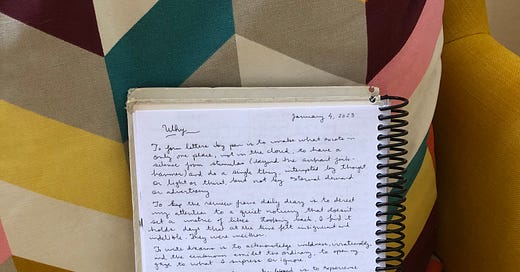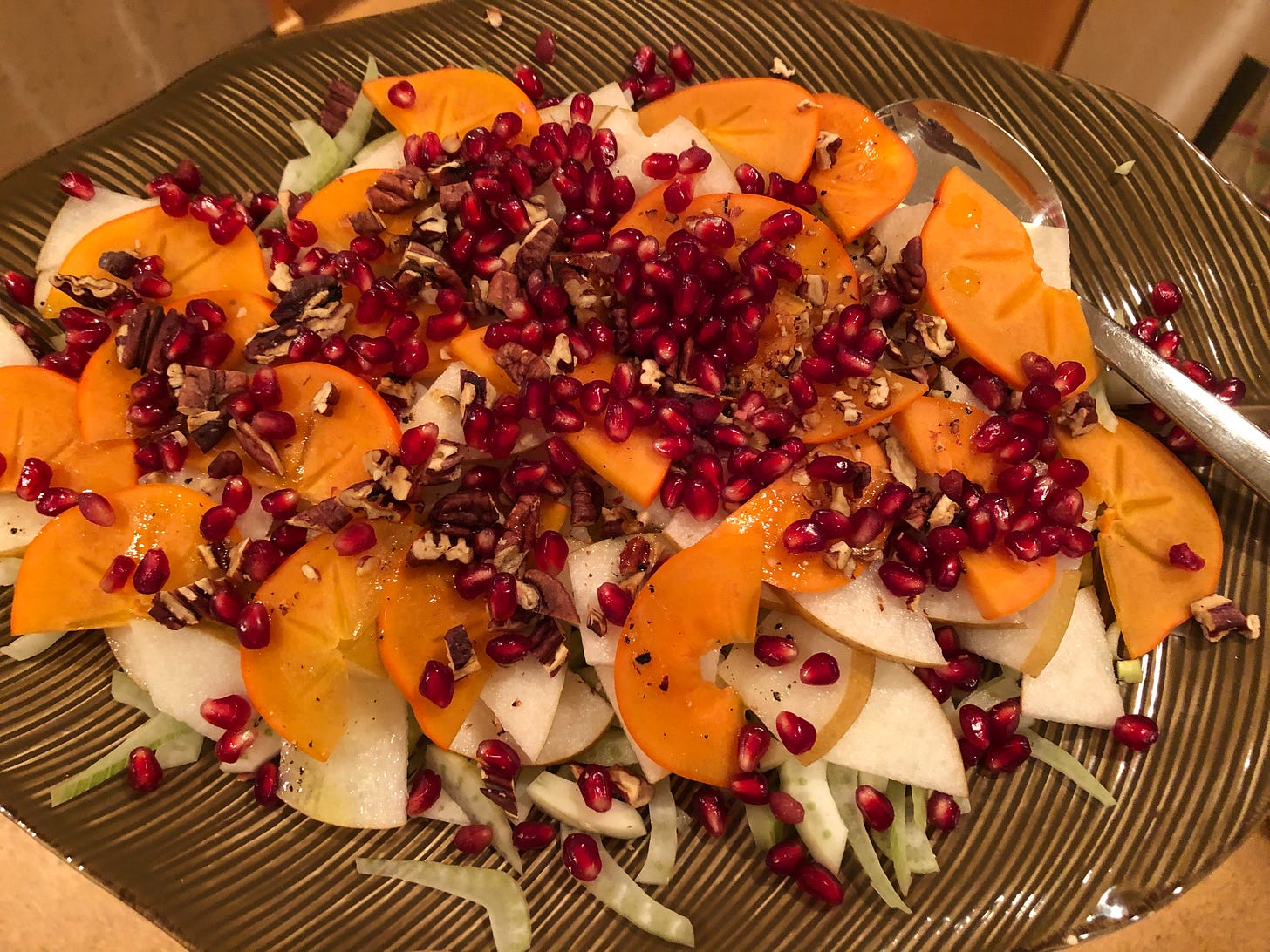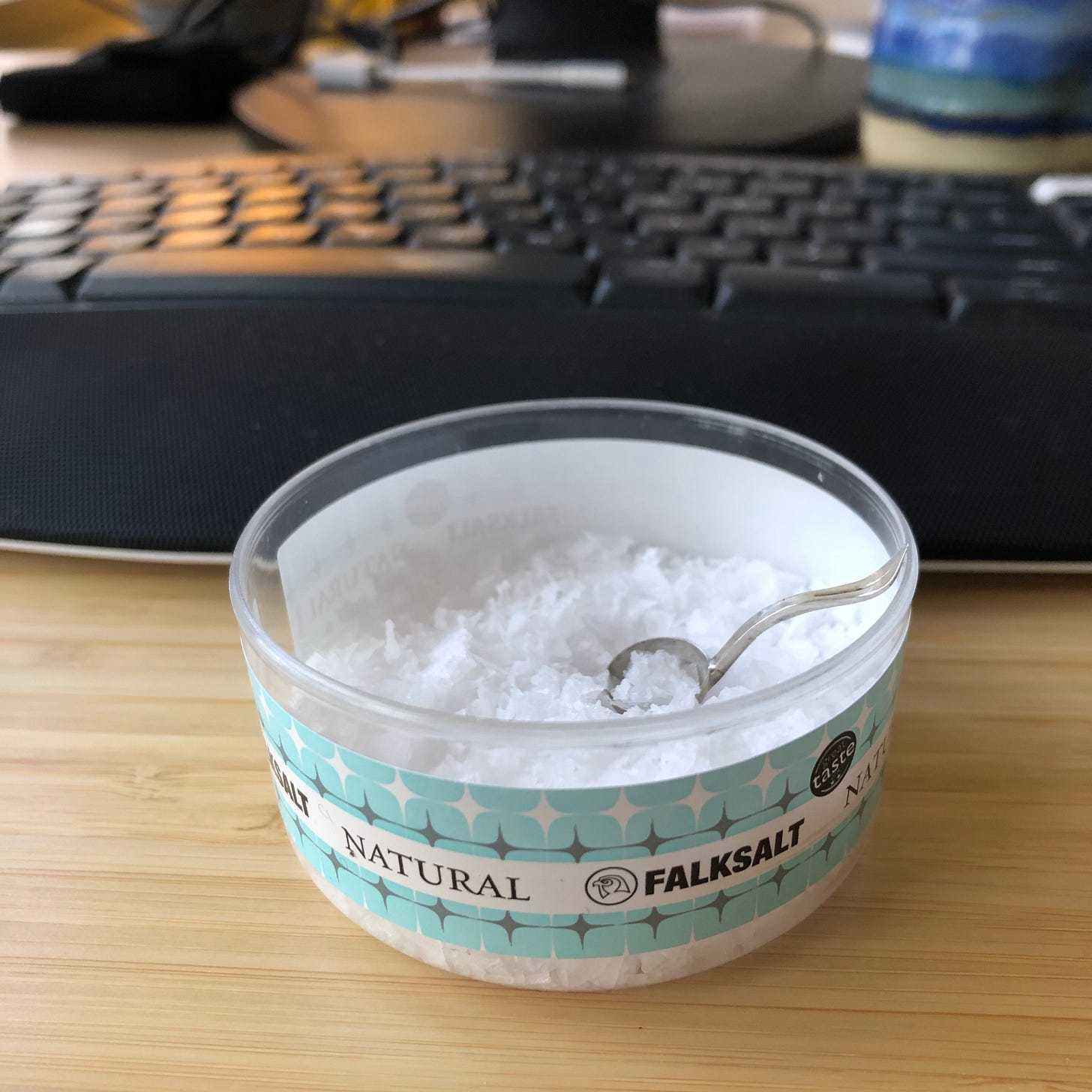Do You Need More Structure or More Space for Intuition? (Or Both?)
Mayonnaise tweets, space for strange aimless sidecars, Amer Latif, purpose, drop-in hours open to you (yes, you), bright winter salad, office salt.
Hello Friends,
Welcome to new folks who subscribed because 1) you just finished Intro to Poetry with me at UBC (such a lovely class! I’m missing you already!), 2) you read my friend Jill’s brilliant newsletter
and saw that she shared an example of the daily diary review frame I use, or 3) you found me through my tweet about my son’s hatred of mayonnaise.
Yeah, that was a weird experience. Here’s the full essay if he’s got you intrigued.
What can I say? We all contain multitudes! However you got here, I’m glad you’re here.
Structure and Intuition
It’s the beginning of a new term once again. This built-in reset at the start of each semester is something I appreciate about my job. In each new schedule, new rhythm, new balance of responsibilities, I have a little window to realign.
As I set my goals and make my schedule for the new term, I’ve been thinking about structure and what I might call intuition (or maybe spontaneity or presence). Often, I’ve had only a small space for my creative work between teaching and parenting responsibilities, and I’ve found it useful to be very explicit in my intentions: “30 minutes of X” or “500 words on Y”. This kind of clarity has helped me enter the work or make time for it when I feel squeezed (and has helped me break huge impossible-seeming things like a Ph.D. dissertation into manageable pieces).
But this term I’m finding myself wondering what can happen if I enclose a period of time by declaring what it ISN’T [not answering emails, not preparing Canvas modules, not emptying the cat boxes, not on my phone, not drafting merit review materials] yet leave openness about what it IS. What happens when I hold the space and let myself feel my way toward what shape that time might take?
In that open space, I’ve found myself gravitating toward practices that often feel like corollaries or supports to writing but not quite writing itself: commonplace book responses to what I’ve been reading, notes on new ideas, writing by hand from a keyword or image, writing dreams.
These are all practices I pick up and put down as my time shifts. Often, they get pushed to the margins in favor of “real writing.” Yet any time I actually look at this “real writing,” it’s clear to me how much of it germanates from what begins in these strange aimless sidecars.
So this time, I’m just letting them have the precious primary time. The most awake, haven’t-opened-my-email, newly-caffeinated-and-optimistic time. And it feels great!
What feels different here is the moment of pause needed to say “what is calling now?” Pausing seems like a huge luxury and a real necessity. A permission.
Sitting with these thoughts, I felt my way to writing into the “why” of each of these practices.
Here’s one example:
To keep a Commonplace Book is to build practice in partial knowledge and contingent insight—both grind against the smooth turn, but in truth they’re the only kind we ever get. To recopy by hand is to walk (thick and crisp and even) in the footsteps of another mind, and in responding, I keep my mind and my making in conversation.
I’m hearing my dear friend and former colleague Amer these words. And I’ve noticed that this moment of clarifying purpose (something I think a LOT about in my teaching) has often shifted something for me. When I remember that the Commonplace Book practice is (among other things) a practice in making peace with partial knowledge, I’m able to begin an entry even if I feel distracted or incoherent or in need of further reflection. And, spoiler alert: the practice itself becomes a source of focus and coherence because it IS an act of reflection.
An Invitation
Take a few minutes to reconnect with (maybe discover?) why want to do the things you’re trying to find time to do. You might try using the “To X is to Y” template that I found so helpful (maybe because it takes the “I” out of the center?)
Drop-In Hours: Now Open to All
As I was setting up my drop-in hours (you know, office hours, but friendlier), it occurred to me that an advantage of doing Zoom drop-in hours (which I’m already doing because I’m teaching in our Optional-Residency MFA program this term) is that I can open them up more broadly. So, if you’re a student from last term or from three or ten1 years ago and you have a question about grad school or want to share a new poem (or get sourdough baking tips), drop in! If you're a writing teacher who wants to chat about an assignment sheet or teaching idea, stop by. I'll give priority to current students, of course, but I'd love to see some familiar (or new) names pop up in my Zoom waiting room.
These start today!
Drop-In Hours Schedule
Wednesdays 2 pm to 3 pm PT in my office (Buchanan E #456
Wednesdays 3 pm to 4 pm PT via Zoom
Here’s a google doc with dates and links (which I’ll update with any cancellations or changes).
Upcoming
I’m looking forward to presenting at AWP in Seattle as part of these two back-to-back panels, packed with brilliant writers and teachers. If you’re planning to be at AWP in March, let me know if you have a panel I can attend (or if you’re organizing a reading that could use another person, or if you want to escape convention building lighting for a coffee walk).
Bright Winter Salad (Greens Optional)
I’ve been making a bunch of variations on this salad recently. Sometimes with lacinato kale sliced into thin ribbons, but sometimes without. Which my kids prefer. Fair enough.
Like most salads, it’s more a template than a recipe.
Combine any number of the following, either in a mixed-together format or in a layered format.
Thinly sliced fennel
Asian pear sliced thinly or cut into little julienne matchsticks. A crisp pear or apple could also work.
Kale (I like dino/lacinato/black kale sliced into thin ribbons). Arugula would also be fine here.2
Pomegranate arils (for color, crunch, and tartness)
Sliced Fuyu persimmon
Toasted pecans (I usually do these in the oven at 350 F for about 8-10 minutes). Other toasted nuts would be fine too.
Toss or drizzle with a simple dressing of olive oil, lemon, salt, and plenty of fresh black pepper. You definitely don’t need everything on the list—any three of these items would still be great! And you could add goat cheese or shaved parmesan if you want, but it’s really not needed (and I say this as someone who puts cheese on pretty much anything she possibly can).
yours, possibly putting cheese on something RIGHT NOW (I brought a little jar of ricotta to put on some of my eggplant and pearl couscous from
that I brought for lunch3),Bronwen
PS: If you liked this post, please hit the heart to let me know! You can also support this newsletter by subscribing, sharing, or commenting.
Or, yes, nineteen years. Hi, David!
Or radicchio if I want to make my kids complain. I actually have another really lovely easy radicchio salad recipe if anyone else shares my fondness for bitter chicories. Let me know.








New here, so firstly hello.
This was a lovely read and really speaks to how I've been trying to frame this year in my mind. I teach university undergrads whilst also trying to maintain a full-time research group (in science; remaining somewhat vague as I'm inclined to remain somewhat anonymous on here for now, partly because I'm toying with thoughts of "is this really what I want to do with my career" etc) and the past few years I've found my own creativity can gets lost in the seemingly stressful onslaught of semester and all the annoying administrative responsibilities and grant writing.
Anyway, I recently read Haruki Murakami's Novelist as a Vocation and -- being a massive Murakami fan -- I found his approach to writing inspirational. He sets daily goals of a set number of words, but puts no pressure on himself as to their quality or content. He just writes. I love your notion of just leaving things open and simply declaring what that timeslot ISN'T. I'm striving for that daily, mostly in the morning because that's when I can feel the tingle of the flow trying to reach me and I can be most open to receiving it, but at times late into the evening.
That's a big ramble, sorry. I just wanted to say how much this article spoke to me and reassured me, so thank you.
I might be more disciplined about my analogue notes from now on. And give myself a window to relax into them. Thanks for your wise words.